Second-Installment Bills will be due December 30, 2022
The Clerk’s Office has completed the calculation of 2021 property tax rates for more than 1,400 taxing agencies in Cook County and released its annual tax rate report Monday.
The Clerk’s Tax Extension Unit is responsible for calculating property tax rates for all local governments in Cook County that authorize the collection of revenue through real estate taxes, according to Clerk Karen A. Yarbrough.
Total Tax Billed Continues to Increase Year Over Year
Once again, the total property tax billed for taxing districts in Cook County continues to steadily increase. Last year the total tax billed was $16.1 billion, this year the total tax billed is over $16.7 billion. This is a nearly 4% increase which is due to several factors such as assessed values, taxing district levies, and the state-issued equalization factor.
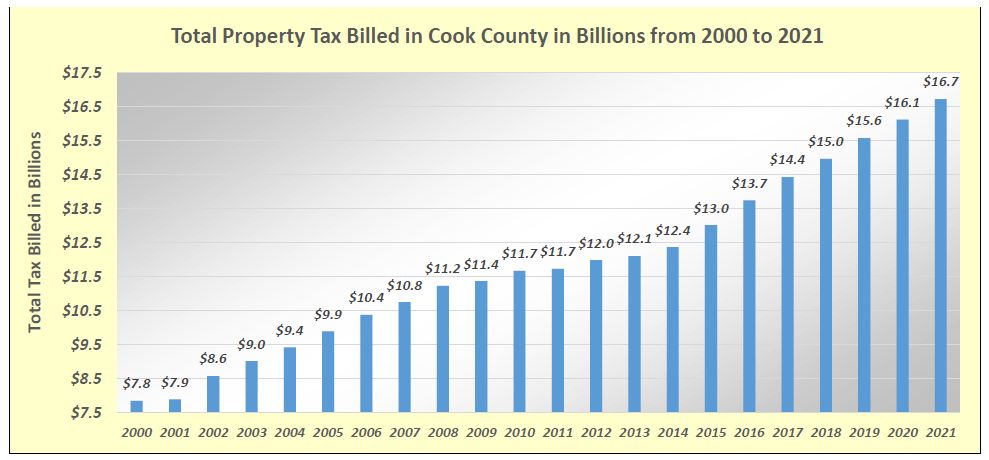
2021 Re-Assessment
Each year one-third of the County is fully reassessed by the Cook County Assessor’s office. The City of Chicago was reassessed for tax year 2021, which is reflected in the tax bills currently payable.
Because of this “triennial” cycle, changes in individual property assessments reflect a three-year difference in property values. For example, the last time most City of Chicago properties were examined by assessment officials was tax year 2018.
The north and northwestern suburbs (suburbs north of North Avenue) are currently being reassessed for tax year 2022.
The south and western suburbs (suburbs south of North Avenue) were reassessed last year (tax year 2020) and will be reassessed again for tax year 2023.
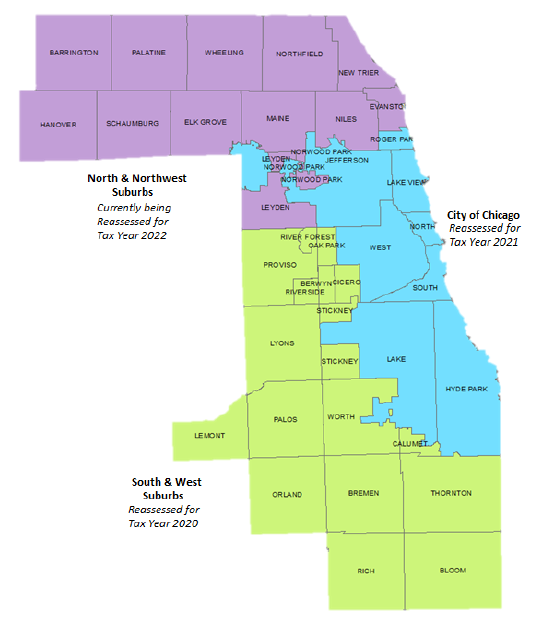
Assessment and Tax Changes by Region
The following charts show the impact of the triennial reassessment on the three regions of Cook County on overall assessed values (AVs) and equalized assessed values (EAVs) in each of the three Cook County regions). The City of Chicago, which was reassessed for tax year 2021, had a total assessment increase of approximately 18% while assessments in the suburbs remained mostly flat.
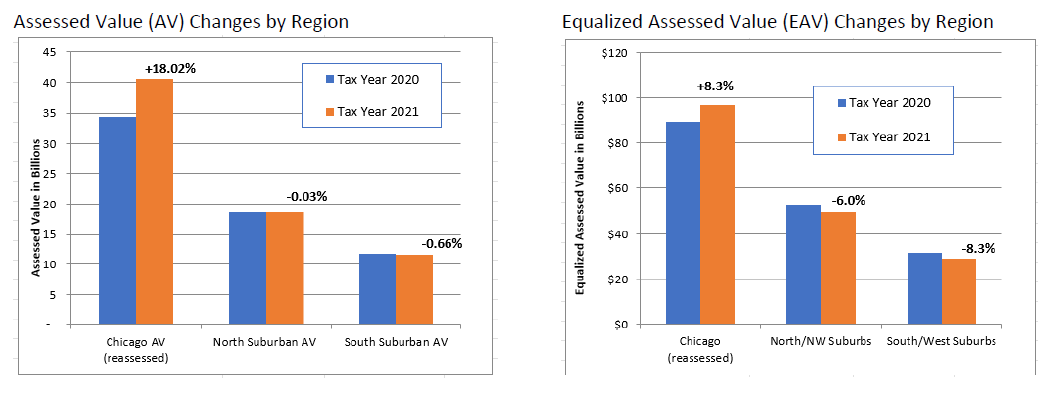
The chart below shows the increase in total tax in each of the three Cook County regions.
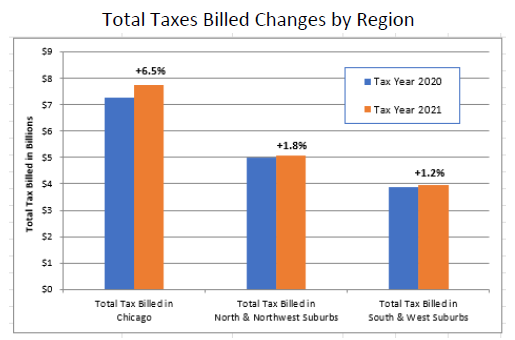
Comparative Property Tax Changes
Increases or reductions in assessed values do not necessarily mean increases or reductions in property taxes to individual properties. Changes in property taxes may be analyzed in many ways such as, but not limited to, by median, average, region, or municipality.
In order to assess the changes impacting Cook County properties as a whole, the following examples utilize average estimated market values of Single-Family Dwellings and Commercial properties to evaluate possible property tax changes by region.
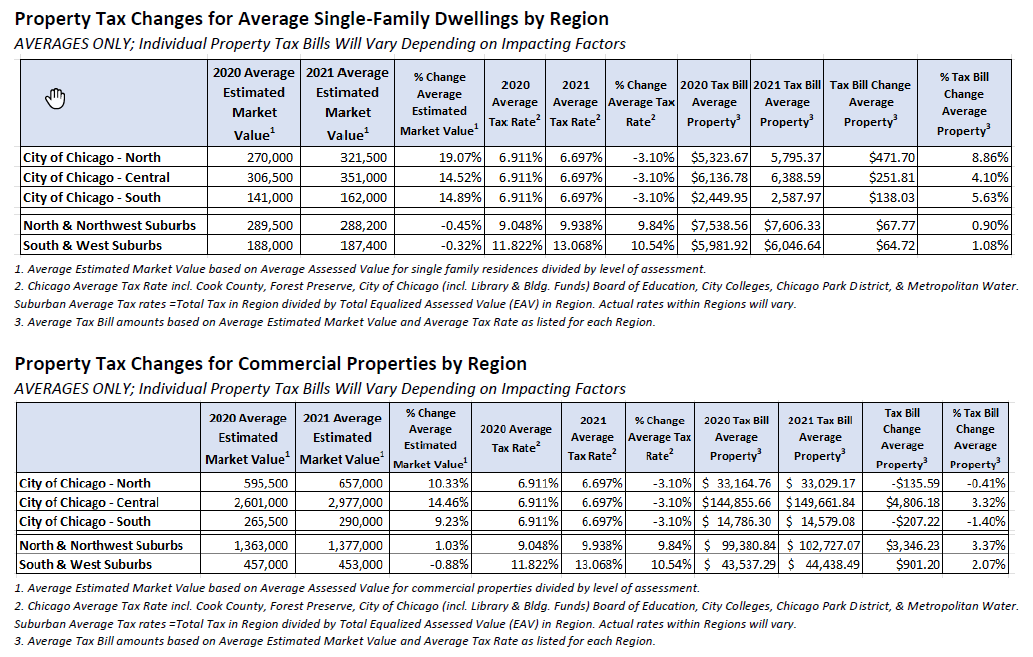

The following table examines possible property tax changes for sample residential properties with the same estimated market value last year (tax year 2020) across three different regions. This reflects the impact of the reassessment in the City of Chicago and overall tax rate changes across each respective region.

The table below examines possible property tax changes for sample commercial properties with the same estimated market value last year (tax year 2020). It illustrates the impact of the reassessment in the City of Chicago and overall tax rate changes across each respective region.
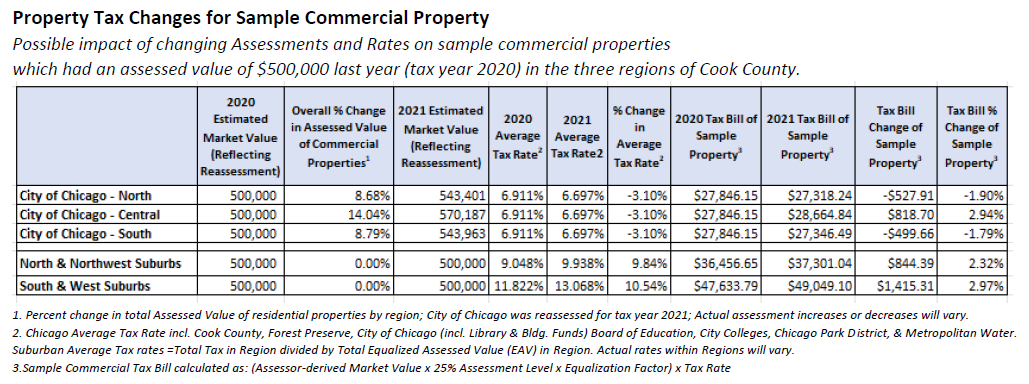
Factors that Impact Property Tax Increases or Decreases
The tables in the previous section provide examples of average trends within Cook County.
The four most impactful factors which affect whether or not individual property tax bills will increase or decrease are:
- The amount of property tax requested by the taxing districts (property tax levies)
- The change in the value of a property relative to other properties within the same districts (property assessment)
- The 6.8% decrease in the state-issued equalization factor compared to the prior year (from 3.2234 for 2020 to 3.0027 for 2021)
- Property tax exemptions. (For example, if a property received a Homeowner Exemption one year, but did not receive it the following year, the final taxable value of that property could be up to 10,000 higher without the exemption.)
In the suburbs, which were not reassessed this year, the average residential tax bill may remain mostly flat. However, with over 1,400 taxing districts servicing over 1.8 million properties of numerous classifications and values, there is a great deal of variability in individual tax bills. Individual tax bills in the suburbs may increase or decrease depending on the combination of taxing districts servicing those properties.
Overview of the City of Chicago
The City of Chicago was reassessed for tax year 2021. Previously, the last time the City was reassessed was for tax year 2018 (bills issued in calendar year 2019).
Unlike the suburbs, in the City of Chicago, where most residents are serviced by the same taxing districts (City of Chicago, Chicago Public Schools, City Colleges, Chicago Park District, Metropolitan Water), there is less variability in tax rates. Therefore, changes in tax amounts for individual properties are heavily influenced by assessment changes.
The overall Assessment increase for residential properties in Chicago this year is approximately 20%.
When that increase is coupled with the 6.8% decrease in the state-issued equalization factor compared to last year and the 3.1% decrease in the City’s general composite tax rate the result is that individual residential properties with a 10% assessment change are likely to see little to no change in their tax bills this year. City properties with larger assessment increases will likely receive higher tax bills and City properties with smaller assessment increases or even decreases may receive lower tax bills compared to last year.
The total tax billed by the major taxing districts in the City of Chicago increased by approximately 4.8%. This tax increase, when offset by the total taxable value increase in the City of Chicago of 8.3%, results in the general composite tax rate in the City of Chicago decreasing approximately 3.1% from 6.911% in 2020 to 6.697% this year.
Individual properties in the City of Chicago with assessed value increases of less than 10.5% will typically experience reduced taxable values and lower tax bills, while those with increases of more than 10.5% will typically experience increased taxable values and higher tax bills.
Assessment Changes in the City of Chicago
The overall assessed value of residential properties in the City of Chicago increased approximately 20% while the overall assessed value of commercial properties increased approximately 13%. The maps below show which regions of the City experienced the greatest assessment increases.
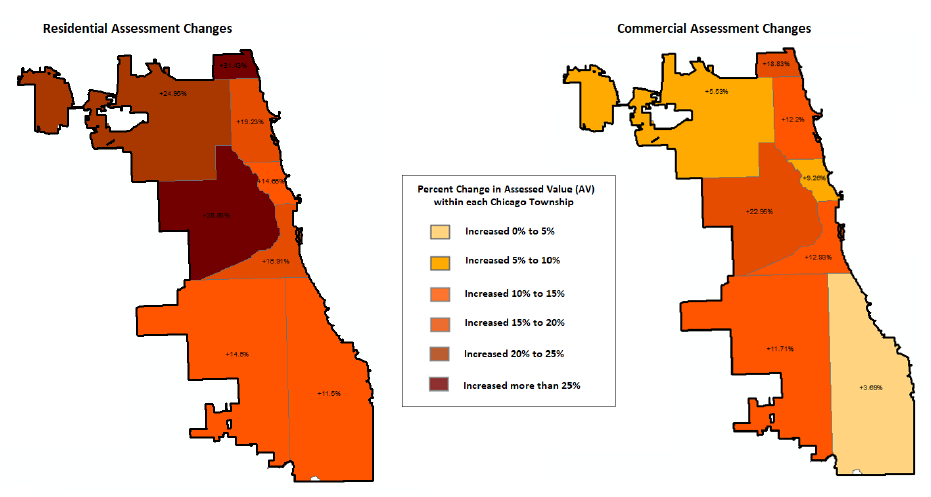
Tax Changes in the City of Chicago
The total amount of tax billed to residential properties in the City of Chicago increased approximately 6% this year compared to last year. The total amount of tax billed to commercial properties increased approximately 2%. The maps below show which regions of the City experienced tax increases and decreases.
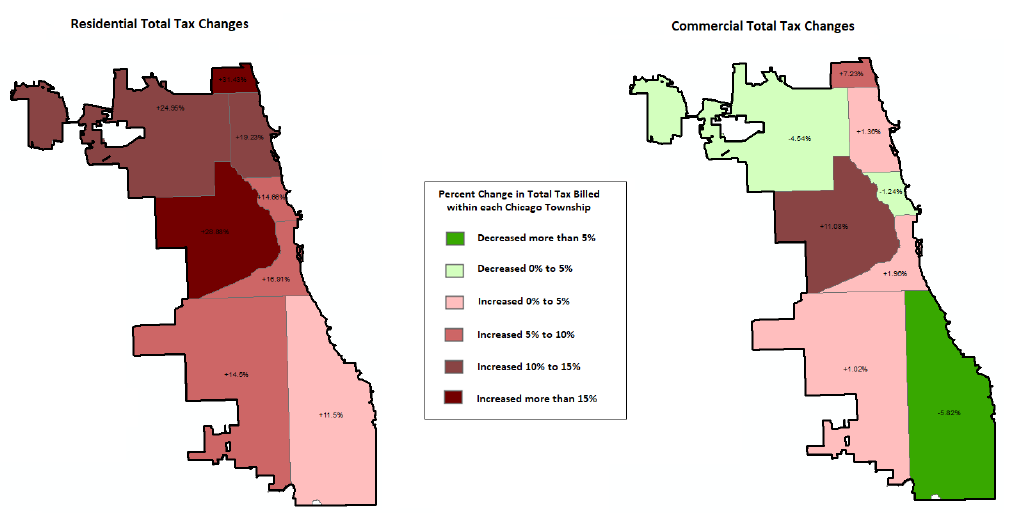
Municipalities with the Largest Increases and Decreases in Total Tax Billed
Below is a map of Cook County displaying the percentage increases or decreases in total property tax billed within each City or Village for tax year 2021. The five municipalities with the largest increases and decreases in total tax are listed in the corresponding table which indicates the variation that can occur in tax bills across the County.
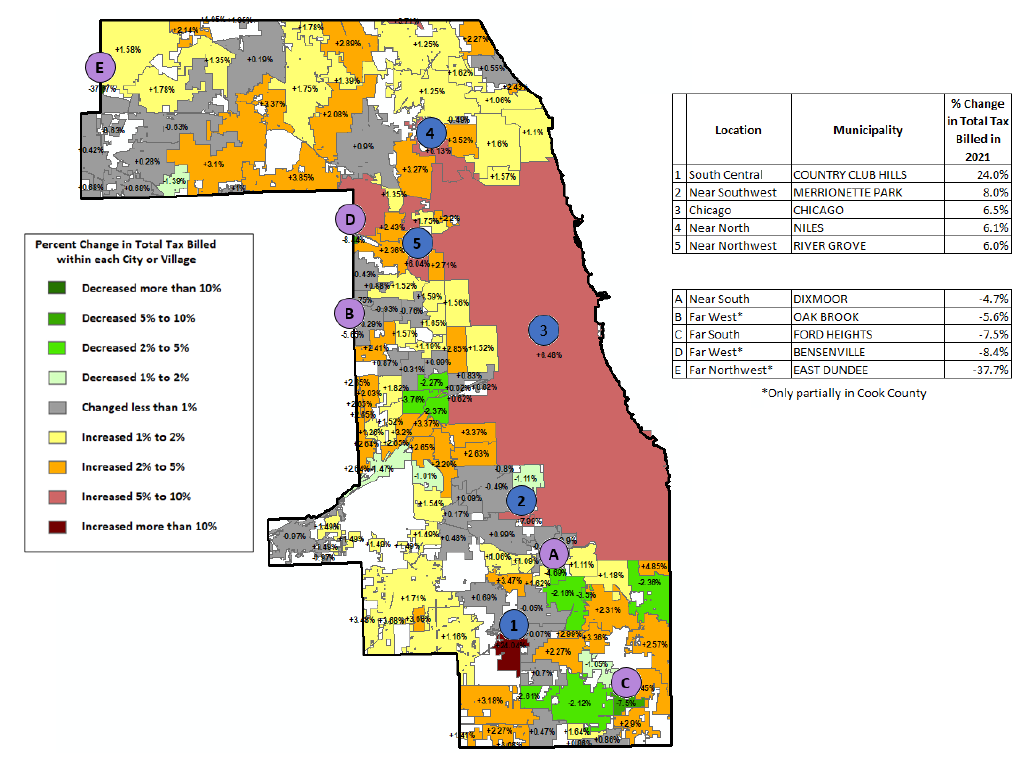
It is important to note that individual properties within each city, village, or township may experience property tax increases or decreases that do not align with the overall tax increase or decrease for that area. For example, not every property in the City of Country Club Hills will experience a property tax bill increase of 24%. In fact, most of the tax increase in Country Club Hills is the result of new developments within the City’s two Tax Increment Financing Districts (TIFs).
Conversely, East Dundee has only two taxable properties within Cook County. The nearly 38% tax reduction in this Village only reflects the portion in Cook County. The majority of the properties in this Village are in Kane County and any tax changes for those properties are not reflected in this report.
Tax rates in the various Cook County suburbs differ due to the large number of municipalities, school districts, park districts, and other taxing districts which provide different services. Specific areas will experience larger or smaller tax changes depending on the taxing districts associated with those areas. Additionally, taxpayers within the same suburb may pay different rates based on the specific taxing districts which provide their services.
Other factors that impact taxes
Property Tax Relief Grants
Several years ago, the State of Illinois authorized the Property Tax Relief Program for eligible school districts. This year, 31 school districts in the south and western suburbs were able to provide property tax relief to their constituents through this program, which provides for a combination of grants and tax levy reductions.
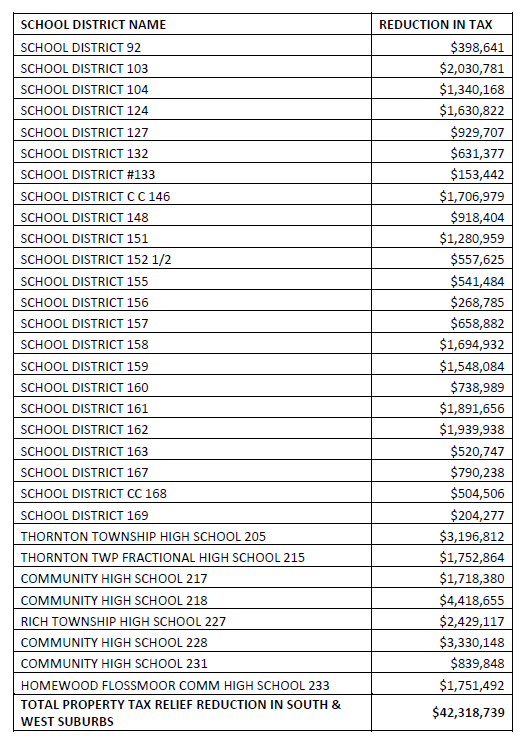
Voter Initiatives
Each election, taxing districts have the opportunity to request voter approval for property tax increases through referenda. The most common types of property tax referendum in Cook County are debt service bonds or exceptions to the Property Tax Extension Limitation Law (PTELL) also known as the “Tax Cap Law”.
This chart reflects taxing districts in which debt service increases were authorized by voters.
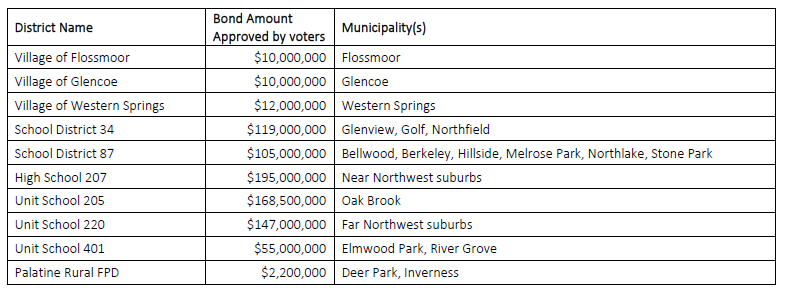
Additionally, voters in School District 113A, which lies in the Villages of Lemont, Palos Park, and Willow Springs, as well as partially within DuPage County, approved a “Limiting Rate Increase” referendum in April 2021. This successful referendum allowed the district to receive more property tax revenue this year than would otherwise have been authorized by the Tax Cap Law.
Summation
- This report has presented the general trends occurring in Cook County. Each tax bill will vary depending on specific circumstances including taxing district levies, individual assessments, and other factors.
- The total tax amount billed in Cook County has increased nearly 4%, exceeding $16.7 billion for tax year 2021.
- The overall taxable value (EAV) in Cook County has increased by just less than 1% for tax year 2021 compared to 2020.
- While specific assessment increases or decreases within the City of Chicago varied by property class and region, the overall assessment within the City increased 18%, primarily due to the three-year reassessment.
- The state-issued Equalization Factor decreased by 6.85% from 3.2234 in 2020 to 3.0027 in 2021. A decreased Equalization factor offsets assessment increases and amplifies assessment decreases.
- In the City of Chicago, overall taxable values increased approximately 8%, as a result of increased assessments and the reduction in the Equalization Factor.
- Tax rates are generally higher in the suburbs and are approximately 3% lower in Chicago this year.
- The 2021 second-installment property tax bills are currently payable online. Tax bills were mailed on December 1 with a due date of December 30, 2022.
###
